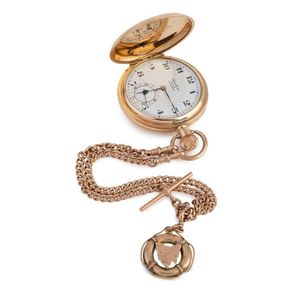Dunklings Rolex Pocket Watch with 9ct Gold Fob Chain
A Rolex rolled gold pocket watch retailed by Dunklings and a 9ct gold fob chain, circa 1920, circular white dial with black Arabic numerals and sub seconds at six, signed Dunklings Rolex Swiss Made, inner lid inscribed, suspended from a gold curb chain, with two swivel clips, t-bar and a circular medallion with a map of Tasmania and rope twist detail, 50 mm diameter, fob chain 27.55gms
You must be a subscriber, and be logged in to view price and dealer details.
Subscribe Now to view actual auction price for this item
When you subscribe, you have the option of setting the currency in which to display prices to $Au, $US, $NZ or Stg.
This item has been sold, and the description, image and price are for reference purposes only.
- Rolled Gold - A type of gold plating devloped in the early 19th century, similar to Sheffield plating of silver, where the the gold is fused under pressure and heat to a base metal, usually brass, and then rolled into sheets of the required thickness.
The thickness of the gold plate can vary. In Britain the thickness of the gold is measured in microns. A micron is one-thousandth of a millimetre and 20 microns of gold is considered good quality. In the USA a differnt method is used that takes account of the total weight of the object.
Also, the purity of the gold, measured in carats can vary, with 24 carat being the purest. The gold in most rolled gold objects will be between 9 and 14 carats.
There are other chemical and electroplating methods of applying gold plate to a base metal, but rolled gold is considered a superior plate to a "gold plated" object.
Depending on the country and date of manufacture, the object may be stamped "Rolled Gold" or similar, but if there is any doubt as to whether an object is solid gold, or some type of gold plating, it is preferable to have it tested by a jeweller. - Circa - A Latin term meaning 'about', often used in the antique trade to give an approximate date for the piece, usually considered to be five years on either side of the circa year. Thus, circa 1900 means the piece was made about 1900, probably between 1895 and 1905. The expression is sometimes abbreviated to c.1900.
This item has been included into following indexes:
